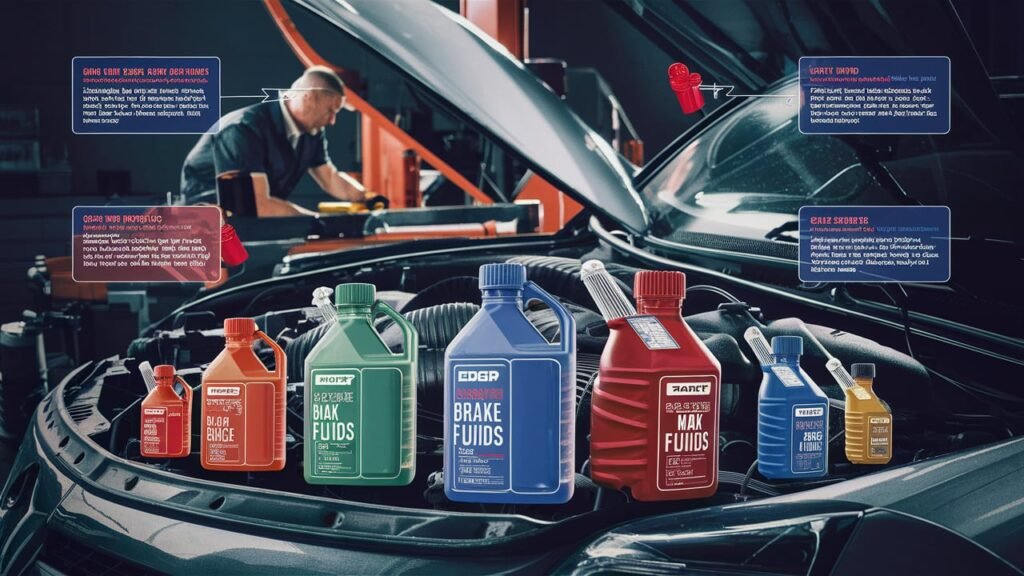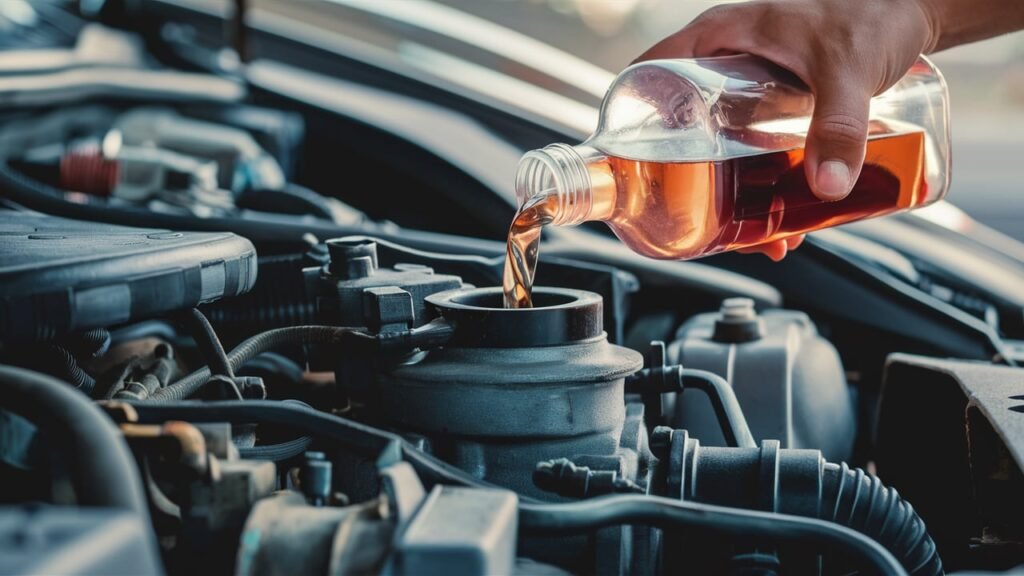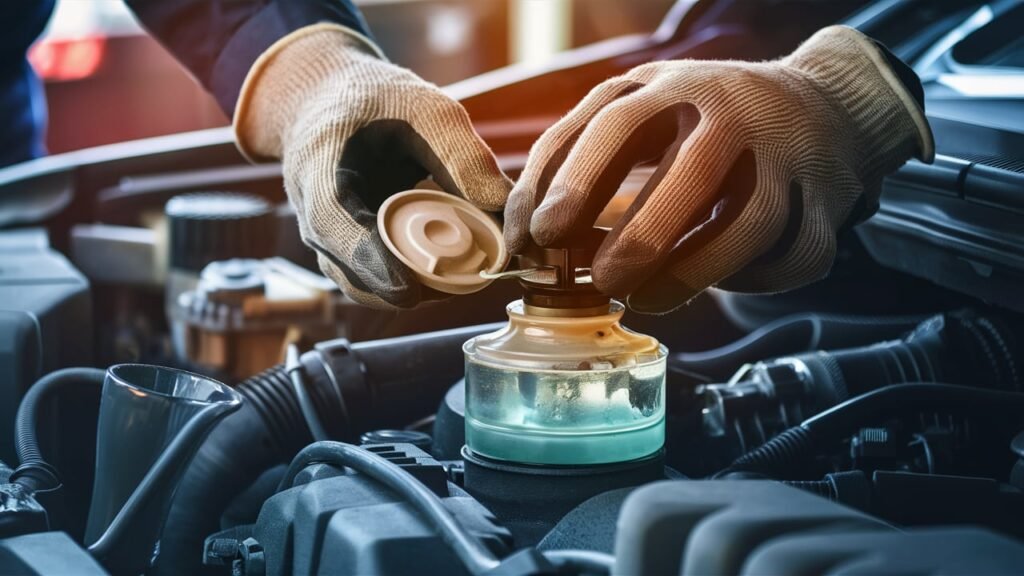
Understanding Car Engine Brake Fluid Types: An In-depth Guide
Car brake fluid comes in several types, each designed for specific vehicle requirements and driving conditions. The main types are:
DOT 3: A standard brake fluid suitable for most everyday vehicles. It can absorb a moderate amount of water and has a lower boiling point than DOT 4 and DOT 5.1. This fluid is satisfactory for general use but may not perform optimally in extreme conditions.
DOT 4: An improved version of DOT 3, with a higher boiling point and additional additives for better performance in higher temperatures and more extreme conditions. This fluid is often used in sports cars or vehicles designed for tougher driving conditions.
DOT 5.1: A glycol-based fluid that absorbs water and is commonly used in modern vehicles. It has a higher boiling point than DOT 3 and is suitable for general use.
DOT 5: A silicone-based fluid that does not absorb water and is typically used in classic cars or vehicles that require non-petroleum-based brake fluids.
Each type of brake fluid has its own characteristics, such as boiling points and moisture absorption, which determine its suitability for specific vehicles and driving conditions.
In the intricate universe of automotive engineering, one vital component silently plays a crucial role in every maneuver and stop: brake fluid. Understanding the significance of this often-overlooked fluid is paramount to maintaining both vehicle performance and safety.
As vehicles evolve with advanced braking systems, the demand for tailored solutions heightens. In this comprehensive guide, we delve into the intricate realm of Car Engine Brake Fluid Types, illuminating the nuances that differentiate DOT 3, DOT 4, and DOT 5 fluids.
Delving beyond surface-level understanding, this article serves as an indispensable compass for mechanics, technicians, and car enthusiasts navigating the labyrinthine choices of brake fluids. An exploration into the functional core of braking systems unveils how precisely calibrated fluids ensure each press on the pedal translates into a reliable halt.
With safety at stake in every mile traveled, discerning between these fluid types becomes not just a choice but a meticulous science—where precision reigns supreme. Join us on this journey through viscosity ratings and temperature thresholds to uncover the threads weaving together what unassumingly holds your vehicle’s stopping power intact.

Embark on an insightful expedition where technical clarity meets practical wisdom. Engage with the nuances underlying brake fluid selections that safeguard both car engines’ longevity and passengers’ security.
Prepare to transcend mere maintenance duties and embrace a newfound depth of knowledge essential for anyone seeking peak performance from their vehicle’s braking system—from seasoned professionals dissecting intricate specifications to DIY car owners keen on mastering their mechanical domain.
Let us chart this course together exploring Car Engine Brake Fluid Types—a trove of expertise awaiting those who seek to decipher the fluent language of vehicular safety mechanisms meticulously composed within every drop of brake fluid in motion.
The Role of Brake Fluid in Vehicle Safety.
Brake fluid serves as a vital component in the hydraulic braking system of vehicles, playing a crucial role in ensuring safe operation on the road. A key function of brake fluid is to transmit force applied by the driver’s foot on the brake pedal to the braking mechanisms at each wheel.
This transmission of force creates hydraulic pressure within the brake lines, causing the brake pads to clamp onto the rotors or drums and subsequently slowing down or halting the vehicle. Without an efficient and properly maintained supply of brake fluid, this process would be severely compromised, jeopardizing stopping distances and overall braking performance.
Using incorrect or degraded brake fluid can have significant implications on the safety of a vehicle. For instance, if moisture accumulates within the brake fluid due to age or contamination, it can lead to decreased boiling points.
This reduced boiling point could result in vapor lock under heavy braking conditions, causing a loss of braking power—a dangerous situation that compromises driver control over the vehicle.

Additionally, incompatible types of brake fluid may contain additives that are not suitable for certain brake system components, potentially leading to seal damage or corrosion within the braking system, further compromising safety.
In summary, understanding the role of brake fluid in vehicle safety highlights its fundamental importance for reliable and effective braking performance. By recognizing how brake fluid facilitates force transmission within the hydraulic system and acknowledging the risks associated with using inadequate or deteriorated fluids, drivers can ensure their vehicles maintain optimal safety standards on the road.
Regularly inspecting and maintaining proper levels of high-quality brake fluid is essential for safe driving practices and preventing potential hazards related to brake system failures.
Types of Car Engine Brake Fluids.
In the world of automotive fluids, understanding the differences between DOT 3, DOT 4, and DOT 5 brake fluids is crucial for maintaining optimal braking performance. The Department of Transportation (DOT) categorizes brake fluids into these classes based on their compositions and properties.
Each type comes with distinct characteristics that make them suitable for various vehicle applications. When selecting the right brake fluid, considering the DOT rating becomes paramount as it directly impacts the safety and efficiency of a vehicle’s braking system.
DOT 3 brake fluid is one of the most commonly used types due to its affordability and compatibility with most vehicles. It is glycol-based and possesses a lower boiling point compared to DOT 4 or DOT 5 formulations. On the other hand, DOT 4 brake fluid offers higher boiling points than DOT 3, making it more resistant to heat buildup during heavy braking conditions.
This increased tolerance to high temperatures makes it ideal for vehicles operating under strenuous conditions like towing or racing. Moving up to DOT 5 brake fluid, we encounter a silicone-based formulation that does not absorb water like its glycol-based counterparts, offering advantages in moisture resistance but requiring specific considerations due to potential compatibility issues with certain systems.
Understanding these distinctions enables car owners and technicians to choose the appropriate brake fluid tailored to their vehicle’s requirements. Whether it’s ensuring consistent daily performance with DOT 3, enhancing thermal stability with DOT 4, or addressing specific needs such as in classic cars with non-ABS systems using DOT 5, comprehension of these variants is imperative for safeguarding both vehicle safety and operational effectiveness.
By being well-versed in the traits of each type and matching them with vehicular demands, professionals can optimize braking systems’ functionality while prolonging their longevity through informed maintenance practices.
Factors Influencing Brake Fluid Selection.
When selecting the appropriate brake fluid for your vehicle, considering various factors is crucial to ensure optimal performance and safety. Temperature ranges play a significant role in determining the effectiveness of brake fluid.
For instance, in regions with extreme temperatures, such as areas experiencing harsh winters or scorching summers, choosing a brake fluid with a suitable boiling point becomes paramount. Higher boiling points prevent brake fade during heavy use and maintain consistent braking performance under challenging conditions.
Moreover, beyond temperature considerations, compatibility with anti-lock braking systems (ABS) and other components in modern vehicles is key. Different brake fluids interact differently with ABS units and rubber seals within the braking system.

Choosing a brake fluid that is compatible with these components ensures proper functioning without causing damage or malfunctions over time. Manufacturers often recommend specific types of brake fluids to maintain system integrity and avoid potential issues arising from incompatible choices.
In conclusion, understanding how temperature variations impact brake fluid performance and ensuring compatibility with ABS systems are critical aspects of selecting the right brake fluid for your vehicle. By taking these variables into account, you can optimize braking system efficiency and longevity while contributing to overall driving safety.
It is essential to consult your vehicle’s manual and seek professional advice when unsure about the most suitable brake fluid type for your specific automotive needs to uphold safety standards and prolong the lifespan of your braking system.
The importance of timely brake fluid.
The importance of timely brake fluid changes cannot be overstated when it comes to maintaining optimal braking performance in vehicles. Manufacturers typically recommend periodic inspection and replacement of brake fluid to ensure the system functions properly.
Neglecting this maintenance aspect can lead to serious safety issues, as brake fluid plays a critical role in transmitting force from the brake pedal to the wheels, enabling efficient stopping power. Over time, moisture absorption becomes a concern with brake fluid.
This moisture infiltration can lower the boiling point of the fluid, potentially resulting in decreased braking effectiveness or even brake failure under extreme conditions.
To illustrate the impact of moisture on brake fluid, consider a scenario where old or contaminated brake fluid causes corrosion within the braking system. The presence of moisture can lead to rust formation on metal components like calipers or cylinders, compromising their functionality and potentially causing leaks.

In such cases, not only is there a risk of reduced braking efficiency, but there’s also a heightened likelihood of more extensive and costly repairs down the line. By adhering to recommended maintenance schedules and changing brake fluid at appropriate intervals, vehicle owners can prevent these issues and uphold safety standards.
It is essential for car owners to understand that regular checks on their vehicle’s brake fluids are fundamental in ensuring safe driving conditions. Visual inspections for signs of contamination or discoloration should not be overlooked since they could indicate moisture seepage into the system.
Moreover, conducting routine tests for water content in the brake fluid can offer insights into its quality over time. By prioritizing timely changes and following manufacturer guidelines for maintenance intervals based on factors like usage patterns and environmental conditions, drivers can uphold the integrity of their braking systems and contribute significantly to road safety.
Step-by-Step Guide to Checking Brake Fluid Quality.
To ensure optimal brake system performance, regularly assessing the quality of your car’s brake fluid is crucial. Begin by visually inspecting the brake fluid reservoir. The fluid should be translucent with a slight yellowish hue for conventional types like DOT 3 or DOT 4. Any discoloration, such as darkening or cloudiness, may indicate contamination and necessitate further evaluation.
In addition to visual cues, conducting a moisture content check provides a more comprehensive assessment of brake fluid condition. One common method involves using a test strip that changes color based on the fluid’s moisture content.
If the strip indicates excessive moisture presence in the fluid, it can compromise braking efficiency due to reduced boiling point and potential corrosion within the braking system.
Regularly examining brake fluid quality not only ensures safety but also helps prevent costly damage to critical components. For example, if moisture accumulation is left unchecked in the brake system due to neglected fluid maintenance, it can lead to accelerated wear on sensitive parts like master cylinders and calipers.
By following these simple steps for checking brake fluid quality, you can proactively maintain your vehicle’s safety and performance.
Common Issues Related to Incorrect Brake Fluid Usage.
Using the wrong type of brake fluid or failing to maintain the correct fluid level can lead to various issues within a vehicle’s braking system. Symptoms such as reduced braking performance, spongy pedals, or a soft brake feel can indicate potential damage due to inappropriate brake fluid selection.
For instance, if a vehicle that requires DOT 4 brake fluid is filled with DOT 3 instead, the lower boiling points of DOT 3 fluid may result in decreased efficiency under high-temperature conditions. Incompatible brake fluids can compromise the hydraulic properties necessary for proper brake operation, ultimately affecting safety on the road.
To address problems stemming from incorrect brake fluid application, it is crucial to identify and rectify any related issues promptly. One solution involves flushing out the contaminated or incompatible brake fluid from the system and refilling it with the appropriate type recommended by the vehicle manufacturer.

This process ensures that the hydraulic components receive the right type of brake fluid necessary for optimal performance. Regular maintenance and adherence to manufacturer specifications regarding brake fluid types can prevent costly repairs and maintain the integrity of the braking system over time.
Furthermore, using old or degraded brake fluids can also lead to inefficiencies in a vehicle’s braking system. Over time, brake fluids absorb moisture from the air, causing a decrease in their boiling points and overall effectiveness. Symptoms like corrosion in braking components or a mushy pedal feel may indicate degraded brake fluid.
In such cases, replacing old brake fluids with fresh ones meeting the required specifications becomes essential to restore proper functionality and ensure safety during braking maneuvers on the road. Regular inspection and proactive replacement based on manufacturer recommendations are vital practices in preventing issues related to deteriorated brake fluids in vehicles.
Best Practices in Handling and Storing Brake Fluids.
Ensuring the integrity of brake fluid begins with proper handling practices to prevent contamination that could compromise its performance. When dealing with brake fluid, it is crucial to avoid exposing it to moisture, which can degrade its effectiveness over time.
One key tip is always to securely seal containers after use to prevent moisture absorption. Additionally, ensuring that all equipment used for handling brake fluid is clean and free from dirt or debris minimizes the risk of introducing contaminants into the fluid.
To preserve brake fluid quality over an extended period, adhering to recommended storage conditions is paramount. Ideally, brake fluid should be stored in a cool, dry place away from direct sunlight and sources of heat.
Extreme temperatures can alter the chemical composition of the fluid, affecting its performance characteristics. By storing brake fluid in a controlled environment within specified temperature ranges, you can maintain its consistency and reliability for when it’s needed in your vehicle.
When storing brake fluid, it’s vital to pay attention to expiration dates and shelf life. Using outdated or expired brake fluid can lead to diminished braking performance due to degradation over time. It is advisable to label containers with the date opened and adhere to manufacturer recommendations regarding shelf life duration.
By rotating stock regularly and properly disposing of expired products, you ensure that only fresh and effective brake fluid is used in your vehicle’s braking system, promoting safety and optimal function on the road.

By following these best practices in handling and storing brake fluids meticulously, you safeguard the quality and efficacy of this critical component of your vehicle’s braking system.
Proper care not only contributes to maintaining safety standards but also preserves the overall functionality of your brakes by ensuring that they operate at peak efficiency when needed most. Adhering to these guidelines fosters longevity and dependability in your braking system while reducing the risks associated with improper storage or handling procedures over time.
Conclusion: Safeguarding Your Vehicle with the Right Choice of Brake Fluid.
In conclusion, selecting and maintaining the correct brake fluid type is paramount to ensuring the safety and optimal performance of your vehicle’s braking system. Throughout this guide, we have delved into the importance of considering factors such as DOT ratings, temperature ranges, and compatibility with various components when choosing the appropriate brake fluid for your car.
By adhering to manufacturer recommendations for periodic inspection and replacement based on brake fluid condition, you can safeguard your vehicle against potential risks associated with degraded or incompatible fluids.
Consistent monitoring of brake fluid quality, along with implementing best practices in handling and storage, will further contribute to the longevity and efficiency of your braking system. Remember to prioritize precision in your selections, carefully following testing procedures to assess fluid condition accurately.
By embracing these guidelines and staying proactive in maintenance routines, you not only enhance safety on the road but also prolong the lifespan of vital braking components in your vehicle. Stay informed, stay vigilant, and let proper brake fluid management be a cornerstone in preserving your vehicle’s functionality and reliability.




